Top Rated Rehab Centers USA: Finding the right rehabilitation facility is crucial for a successful recovery. According to U.S. News & World Report, 43 hospitals have been recognized with CARF-accredited medical rehabilitation programs as among the top 50 hospitals for rehabilitation in “America’s Best Hospitals for Adult Rehabilitation 2024-25.”
We understand the importance of selecting a premier treatment center that provides exceptional care for various conditions, including substance abuse and mental health treatment. Our comprehensive guide explores the nation’s top rehabilitation facilities, examining their accreditations, specialized programs, and treatment approaches.
Key Takeaways
- Top rehabilitation facilities in the USA offer expert care for substance abuse and mental health treatment.
- CARF accreditation is a mark of excellence in rehabilitation programs.
- Specialized programs and treatment approaches vary across top-rated centers.
- Understanding the factors that contribute to successful recovery is crucial.
- Our guide provides valuable insights to help you make informed decisions about rehabilitation care.
Best Clinics for Rhinoplasty in USA: Our Expert Reviews
Understanding Rehabilitation Treatment Options
The journey to recovery begins with understanding the diverse rehabilitation treatment options available, from inpatient programs to specialized therapeutic approaches. At an average cost of $13,475 per person for drug rehabilitation, the financial investment is significant, but so is the potential for a successful recovery.
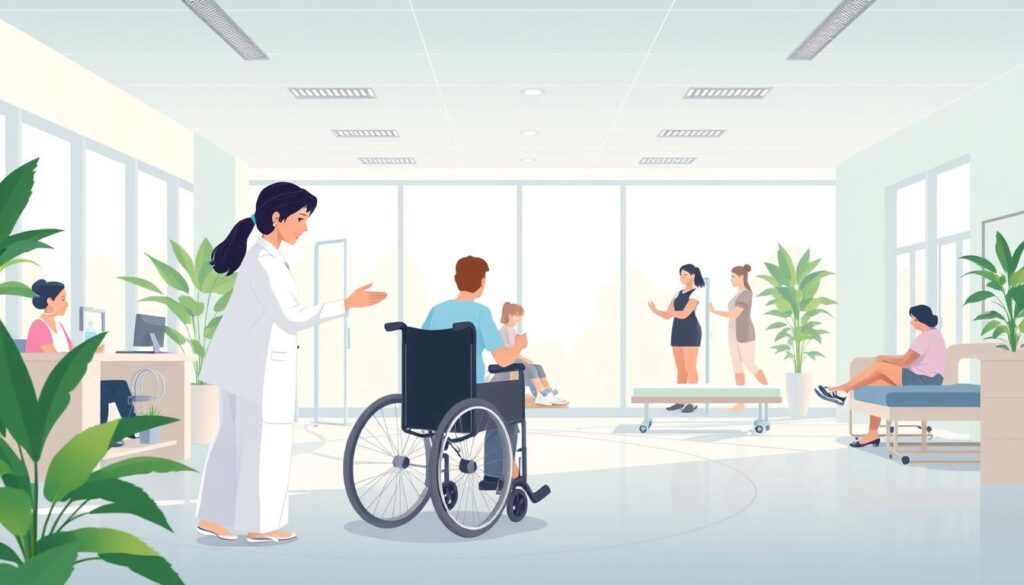
Rehabilitation treatment options vary widely in approach, duration, and intensity, catering to different needs and circumstances. We recognize that effective rehabilitation often requires specialized approaches tailored to specific conditions and individual needs.
Inpatient vs. Outpatient Programs
Inpatient and outpatient programs are two primary rehabilitation treatment options. Inpatient programs provide 24/7 care in a residential setting, ideal for those requiring intensive therapy and support. Outpatient programs, on the other hand, offer flexibility, allowing individuals to receive treatment while living at home.
- Inpatient programs are beneficial for severe cases of addiction or substance abuse.
- Outpatient programs are suitable for those with less severe addiction or with strong support systems.
Specialized Treatment Approaches
Many top-rated facilities offer evidence-based treatment modalities such as Cognitive Behavioral Therapy (CBT), Dialectical Behavior Therapy (DBT), and Motivational Enhancement Therapy. Additionally, holistic treatment approaches that address the mind, body, and spirit through activities like yoga, meditation, art therapy, and nutritional counseling are increasingly common.
- Medication-assisted treatment (MAT) combines behavioral therapy with medications to treat substance use disorders.
- Trauma-informed care incorporates therapeutic techniques to address underlying issues related to past trauma.
By understanding these rehabilitation treatment options, individuals can make informed decisions about their care, taking the first step towards a successful recovery.
The Cost of Rehabilitation Treatment in America
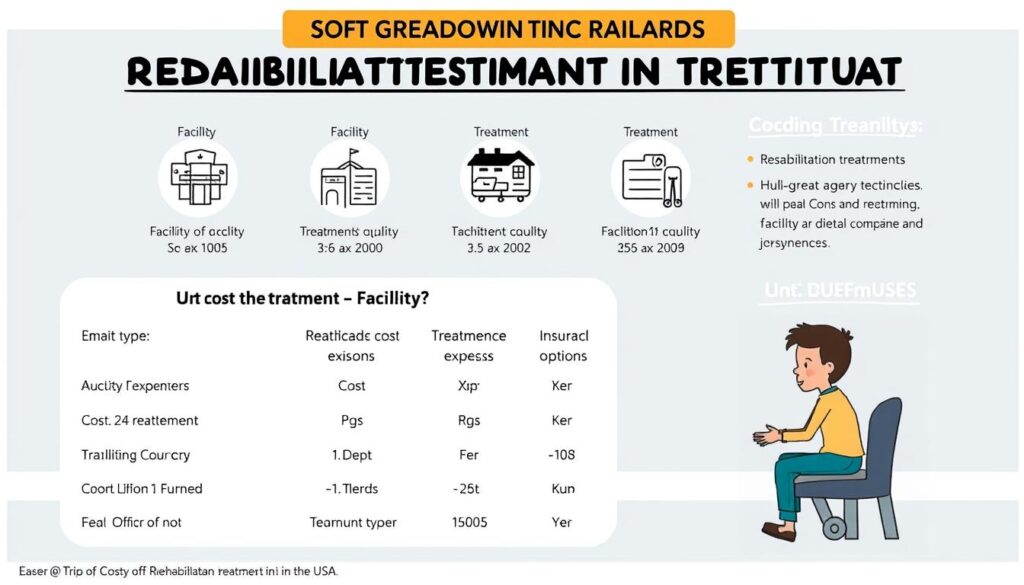
Rehabilitation treatment costs in America can vary significantly based on several factors, including the type of treatment, the intensiveness of the program, and the patient’s insurance coverage. Understanding these costs is crucial for individuals seeking rehabilitation services.
Several variables influence the cost of rehabilitation treatment, making it essential to explore the different options available. The cost can be affected by whether the treatment is inpatient or outpatient, the duration of the program, and the specific services offered.
Average Costs by Treatment Type
The average cost of rehabilitation treatment varies widely depending on the type of program. Inpatient programs, which provide 24/7 care, tend to be more expensive than outpatient programs. Drug rehab costs can also differ based on the treatment approach and the qualifications of the staff.
For instance, luxury rehab centers with private accommodations and holistic treatment approaches can be quite costly. On the other hand, standard rehab facilities offering group therapy and basic amenities may be more affordable.
Insurance Coverage and Payment Options
Understanding insurance coverage is vital, as the Mental Health Parity and Addiction Equity Act requires most insurance plans to cover substance abuse and mental health treatment at levels comparable to medical coverage.
- Many private insurance plans cover a significant portion of rehabilitation costs, though coverage varies widely in terms of approved facilities, treatment duration, and required co-payments or deductibles.
- Medicare and Medicaid can provide coverage for rehabilitation services for eligible individuals, though finding facilities that accept these government insurance programs may be more challenging.
- For those without adequate insurance coverage, many rehabilitation centers offer financing options, sliding scale fees based on income, or scholarship programs to make treatment more accessible.
- Some facilities work with specialized healthcare lenders who provide loans specifically for medical and rehabilitation treatments, offering another payment option for those who need assistance.
It’s also worth noting that 443 facilities in the United States offer free treatment for all clients, providing a vital safety net for those in need.
Top Rated Rehab Centers USA: Elite Facilities for Recovery
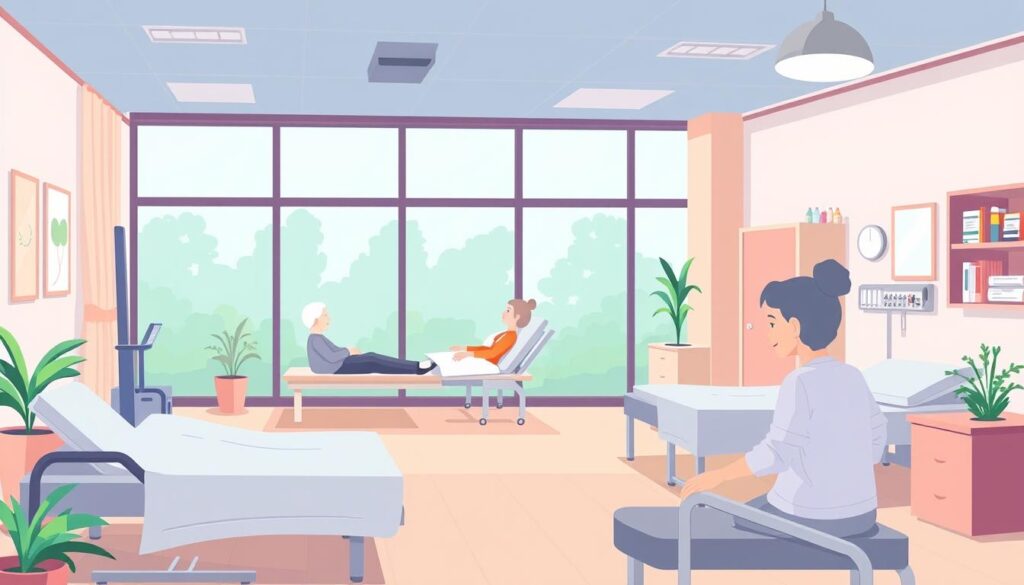
The top-rated rehab centers in the USA are recognized for their exceptional care and innovative treatment approaches. These elite facilities are dedicated to providing high-quality rehabilitation services to patients, helping them achieve optimal recovery outcomes.
How Rehab Centers Are Ranked
Rehabilitation centers are ranked based on various factors, including patient outcomes, staff expertise, and the quality of care provided. Rankings from reputable sources like U.S. News & World Report help patients make informed decisions about their care.
CARF Accreditation and Quality Standards
CARF accreditation is a mark of excellence in the rehabilitation industry, indicating that a facility has met rigorous standards for quality and safety. Patients can trust that CARF-accredited centers provide high-quality care.
U.S. News & World Report Rankings
U.S. News & World Report’s “America’s Best Hospitals for Adult Rehabilitation 2024-25” recognized 43 hospitals with CARF-accredited medical rehabilitation programs among the top 50 ranked hospitals for rehabilitation. We value these rankings as they provide an objective assessment of rehabilitation hospitals based on multiple quality measures and expert opinions.
The annual rankings serve as a valuable resource for patients seeking high-quality rehabilitation care, highlighting facilities that consistently demonstrate excellence. Being included in these prestigious rankings indicates that a facility has achieved recognition from both peers and independent evaluators for their exceptional rehabilitation services.
- We value the U.S. News & World Report rankings as they provide an objective assessment of rehabilitation hospitals based on multiple quality measures and expert opinions.
- Their methodology evaluates factors such as patient safety, nurse staffing, technology, and reputation among specialists to determine the top rehabilitation facilities.
- The annual rankings serve as a valuable resource for patients seeking high-quality rehabilitation care, highlighting facilities that consistently demonstrate excellence.
- Being included in these prestigious rankings indicates that a facility has achieved recognition from both peers and independent evaluators for their exceptional rehabilitation services.
- The U.S. News & World Report rankings are widely respected and often influence referral patterns among healthcare providers seeking the best care for their patients.
By choosing a top-rated rehab center, patients can be confident that they are receiving the best possible care from experienced professionals. These facilities are committed to delivering exceptional rehabilitation services that cater to the unique needs of each patient.
Premier Rehabilitation Hospitals in the Northeast
Renowned for their excellence in rehabilitation medicine, several hospitals in the Northeast have earned top spots in national rankings. These esteemed institutions offer a range of comprehensive services and state-of-the-art facilities, making them ideal for patients seeking high-quality care.
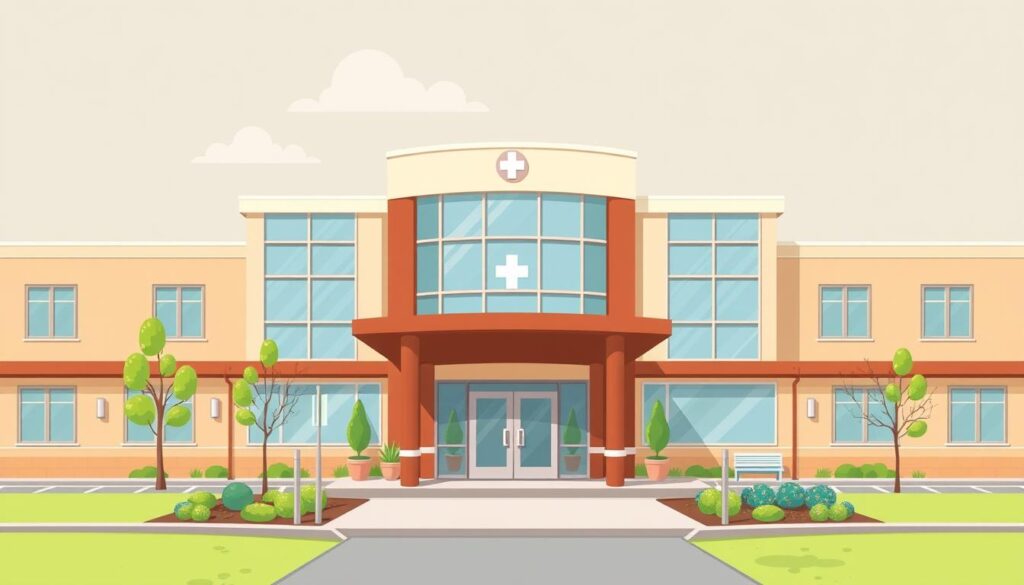
Spaulding Rehabilitation Hospital, Boston
Spaulding Rehabilitation Hospital in Boston is a leading provider of rehabilitation services, offering care for a wide range of conditions, including stroke, spinal cord injuries, and neurological disorders. The hospital’s team of experts works closely with patients to develop personalized treatment plans that address their unique needs and goals.
The hospital’s facilities are equipped with the latest technology, ensuring that patients receive the most effective and innovative treatments available. With a strong focus on patient-centered care, Spaulding Rehabilitation Hospital is dedicated to helping individuals achieve optimal recovery and regain their independence.
Rusk Rehabilitation at NYU Langone, New York
Rusk Rehabilitation at NYU Langone in New York is recognized among the top-ranked hospitals for rehabilitation in U.S. News & World Report’s “America’s Best Hospitals for Adult Rehabilitation 2024-25.” As a pioneering institution in rehabilitation medicine, Rusk has a legacy dating back to Dr. Howard Rusk’s groundbreaking work in the field.
The center offers comprehensive inpatient and outpatient rehabilitation services for adults and children with disabilities resulting from illness or injury. Rusk’s specialized programs address a wide range of conditions, including stroke, traumatic brain injury, spinal cord injury, orthopedic impairments, and neurological disorders. The integration with NYU Langone Health provides patients with seamless access to world-class medical specialists and advanced diagnostic capabilities, enhancing the rehabilitation process.
Leading Rehabilitation Centers in the South

Leading rehabilitation centers in the South offer a range of treatment services for patients. These facilities provide comprehensive care for individuals recovering from various conditions, including spinal cord injuries, brain injuries, and addiction.
TIRR Memorial Hermann, Houston
TIRR Memorial Hermann is a renowned rehabilitation hospital located in Houston, Texas. The hospital offers a wide range of services, including physical therapy, occupational therapy, and speech therapy. Their team of experts works closely with patients to develop personalized treatment plans tailored to their specific needs.
Shepherd Center, Atlanta
The Shepherd Center in Atlanta, Georgia, is recognized as one of the top-ranked hospitals for rehabilitation in U.S. News & World Report’s “America’s Best Hospitals for Adult Rehabilitation 2024-25.” This premier private, not-for-profit hospital specializes in medical treatment, research, and rehabilitation for people with spinal cord injury, brain injury, multiple sclerosis, and other neuromuscular conditions.
Founded in 1975, the center has grown from a six-bed rehabilitation unit to a world-renowned, 152-bed hospital that treats more than 900 inpatients and 7,000 outpatients annually. Shepherd Center’s specialized programs include dedicated units for spinal cord injury, acquired brain injury, dual diagnosis for brain injury and substance abuse, multiple sclerosis, and chronic pain.
The facility offers a comprehensive continuum of care, from intensive care to rehabilitation and lifelong follow-up, ensuring patients receive appropriate support throughout their recovery journey. Shepherd’s Beyond Therapy program provides activity-based therapy using state-of-the-art equipment to help patients with neurological disorders improve their overall health, fitness, and quality of life.
Both TIRR Memorial Hermann and Shepherd Center are exemplary models of rehabilitation centers in the South, providing exceptional care and services to patients. By leveraging their expertise and state-of-the-art facilities, these centers help individuals achieve optimal recovery outcomes.
Outstanding Rehabilitation Facilities in the Midwest
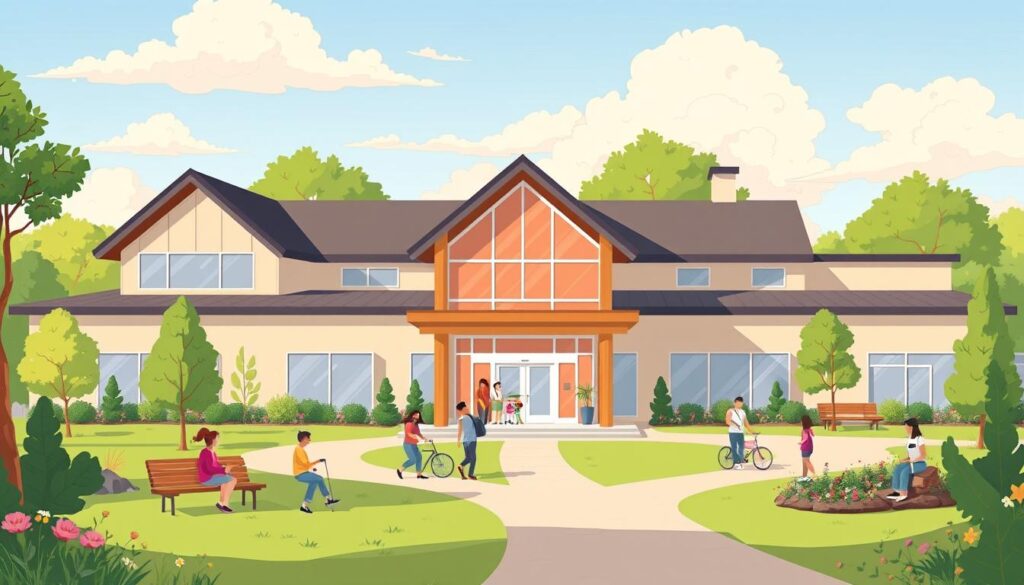
The Midwest boasts an array of exceptional rehabilitation facilities that cater to diverse patient needs. These centers are equipped with state-of-the-art technology and staffed by professionals who are dedicated to providing comprehensive care.
Mayo Clinic Hospital, Rochester
The Mayo Clinic Hospital in Rochester is a leading rehabilitation center known for its innovative treatment approaches and patient-centered services. The hospital’s rehabilitation program is designed to help patients recover from a variety of conditions, including stroke, brain and spinal cord injuries, and amputation.
Shirley Ryan AbilityLab, Chicago
Formerly known as the Rehabilitation Institute of Chicago, the Shirley Ryan AbilityLab is consistently recognized as a global leader in physical medicine and rehabilitation. The facility’s innovative design brings researchers, clinicians, and patients together in shared spaces called “AbilityLabs,” focused on specific functions like walking, hand function, and cognition.
- We consider the Shirley Ryan AbilityLab to be a global leader in physical medicine and rehabilitation, pioneering the “AbilityLab” concept that integrates research with clinical care.
- The facility specializes in treating complex conditions including stroke, brain and spinal cord injury, amputation, and chronic pain.
- The center’s research enterprise is one of the largest of its kind in the world, with scientists working alongside clinicians to develop and implement new treatment protocols.
Both Mayo Clinic Hospital and Shirley Ryan AbilityLab are exemplary models of rehabilitation facilities in the Midwest, offering a range of services and treatment options that cater to the diverse needs of patients. These hospitals and centers are committed to delivering high-quality care and support to individuals on their path to recovery.
Top-Tier Rehabilitation Centers on the West Coast

The West Coast boasts a range of exceptional rehabilitation centers that cater to diverse patient needs. These facilities are equipped with state-of-the-art technology and staffed by professionals who are dedicated to providing high-quality care.
Rancho Los Amigos National Rehabilitation Center
Located in Downey, California, Rancho Los Amigos National Rehabilitation Center is a leading provider of rehabilitation services. The center offers a comprehensive range of programs for patients with various conditions, including spinal cord injuries and traumatic brain injuries.
Its multidisciplinary team of healthcare professionals works together to create personalized treatment plans that address the unique needs of each patient.
Santa Clara Valley Medical Center
Santa Clara Valley Medical Center in San Jose, California, is recognized among the top-ranked hospitals for rehabilitation in U.S. News & World Report’s “America’s Best Hospitals for Adult Rehabilitation 2024-25.” The center’s Rehabilitation Center is a leader in providing comprehensive rehabilitation services for patients with traumatic brain injuries, spinal cord injuries, and other complex conditions.
- One of the largest traumatic brain injury units in California, offering specialized care for patients in all stages of recovery.
- A spinal cord injury program designated as a Model System by the National Institute on Disability, Independent Living, and Rehabilitation Research.
- A Pediatric Rehabilitation Program that provides specialized services for children and adolescents with acquired or congenital disabilities.
- Their Traumatic Brain Injury Model System conducts important research on brain injury rehabilitation, contributing to advancements in treatment approaches and outcomes measurement.
Both Rancho Los Amigos National Rehabilitation Center and Santa Clara Valley Medical Center are exemplary rehabilitation centers that demonstrate a commitment to delivering high-quality services and treatment to their patients.
Residential Addiction Treatment Programs

For individuals struggling with substance abuse, residential treatment centers provide a supportive environment where they can focus on their recovery. These centers offer comprehensive residential addiction treatment programs tailored to meet the unique needs of each patient.
Residential addiction treatment programs are designed to provide intensive care and support to individuals dealing with substance abuse issues. The services offered at these centers include counseling, therapy, and medical care, all aimed at helping patients overcome their addiction.
Long-Term vs. Short-Term Programs
Residential treatment programs vary in duration, offering both long-term and short-term options. The choice between these depends on the individual’s needs and the severity of their addiction. Drug rehab programs are designed to be flexible, accommodating different lengths of stay.
Long-term programs provide extended care and support, which can be crucial for individuals with severe addiction. In contrast, short-term programs offer a more condensed treatment plan, suitable for those with less complex needs.
Therapeutic Communities
Therapeutic communities are a type of residential treatment program that focuses on creating a supportive community environment. These communities are highly structured, with a hierarchical model that promotes personal and social responsibility among residents.
- We recognize therapeutic communities as highly structured residential programs where the community itself serves as the primary agent of change, helping residents examine damaging beliefs and destructive behaviors.
- These programs typically employ a hierarchical model with treatment stages that reflect increased levels of personal and social responsibility as residents progress through the program.
- Therapeutic communities emphasize personal accountability, with community members providing feedback to one another and helping to reinforce positive behavioral changes.
- Many therapeutic communities incorporate work therapy, where residents contribute to the functioning of the facility while developing vocational skills and a sense of responsibility.
- Research has shown therapeutic communities to be particularly effective for individuals with severe substance use disorders, especially those with criminal justice involvement or histories of chronic relapse.
The cost of therapeutic community treatment has increased over the years, currently ranging between $20,430 and $44,616, with an average length of stay of 33 weeks. This substance abuse treatment approach is recognized for its effectiveness in promoting long-term recovery.
By providing a comprehensive and supportive environment, residential addiction treatment centers play a crucial role in helping individuals overcome addiction. The rehab treatment services offered at these centers are designed to meet the unique needs of each patient, ensuring they receive the care and support necessary for a successful recovery.
Detoxification Programs and Services

The journey to recovery from substance abuse typically starts with a detoxification program. Detoxification is a medically supervised process that helps patients overcome their dependence on substances. At our facilities, we offer comprehensive detoxification services tailored to the needs of our patients.
Our detoxification programs are designed to provide a safe and supportive environment for individuals to begin their recovery journey. With a focus on medical detox protocols and innovative approaches like rapid detox, we cater to a wide range of patient needs.
Medical Detox Protocols
Medical detox protocols involve the use of medications to manage withdrawal symptoms and cravings. These protocols are designed to be safe and effective, ensuring that patients are comfortable throughout the detox process. Our medical team closely monitors patients and adjusts treatment plans as necessary to provide optimal care.
By leveraging the latest in medical research and technology, our detox protocols are tailored to address the specific needs of each patient, whether they are struggling with opioid, alcohol, or other substance dependencies.
Rapid Detox Options
Rapid detox, also known as ultra-rapid detox, is a controversial procedure that aims to speed up the withdrawal process by placing patients under general anesthesia while administering opioid antagonist medications. This approach is primarily used for opioid detoxification and claims to compress the withdrawal timeline from days to hours while the patient is unconscious.
- Rapid detox can cost anywhere from $5,000 to $10,000, averaging $7,500.
- Medical organizations, including the American Society of Addiction Medicine, have expressed concerns about rapid detox due to significant risks, including respiratory distress, cardiac complications, and even fatalities in some cases.
- The procedure is typically not covered by insurance due to limited evidence supporting its effectiveness and safety concerns raised by medical professionals.
- While rapid detox may shorten the acute withdrawal period, it does not address the psychological aspects of addiction or provide the coping skills necessary for long-term recovery.
Intensive Outpatient and Partial Hospitalization Programs
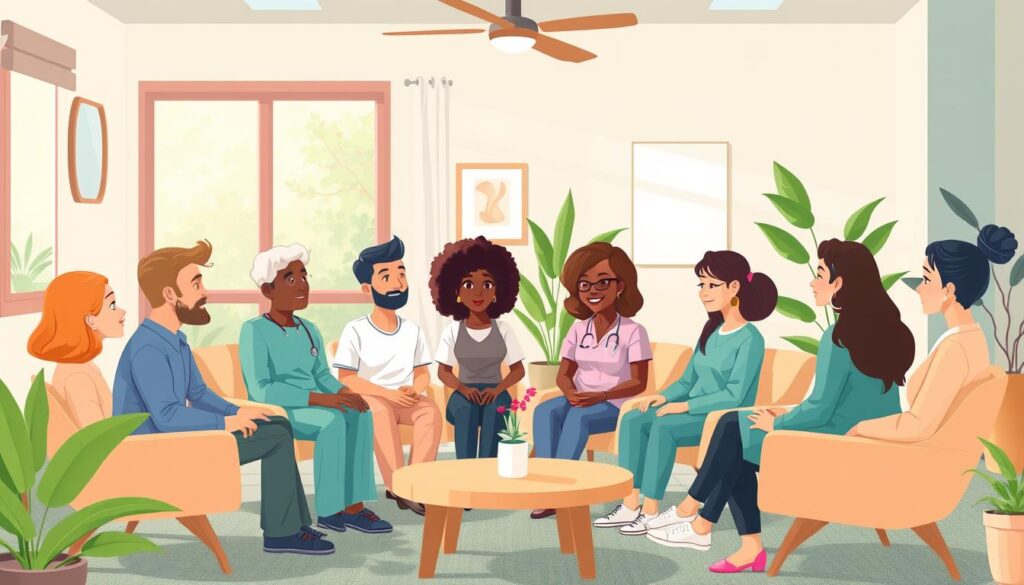
Intensive outpatient programs (IOPs) and partial hospitalization programs (PHPs) offer flexible, effective treatment options for individuals struggling with substance abuse and mental health issues. These programs cater to those who require structured services but do not need 24/7 supervision.
Structure and Time Commitment
IOPs typically involve 9-20 hours of weekly treatment, spread across 3-5 days, allowing patients to maintain their daily routines while receiving intensive care. In contrast, PHPs are more demanding, requiring 20+ hours weekly across 5-7 days. This flexibility in drug rehab programs enables patients to choose the level of care that best suits their needs.
Effectiveness and Success Rates
Research indicates that IOPs and PHPs can be as effective as inpatient treatment for many individuals, particularly those with stable living environments and strong support systems. The success of these programs depends on various factors, including the specific substance used, presence of co-occurring disorders, patient engagement, and continuation of care after program completion. Studies show that patients who complete the full recommended duration of IOP or PHP treatment show significantly better outcomes.
Long-term success is strongly correlated with ongoing participation in continuing care, such as regular outpatient therapy, support groups, or recovery community organizations after completing the intensive phase of substance abuse treatment. By providing comprehensive services and support, we can enhance the effectiveness of these programs and help patients achieve lasting recovery.
State-by-State Rehabilitation Options

When seeking rehabilitation, it’s crucial to understand that treatment options can differ greatly from state to state. The United States offers a diverse range of rehabilitation programs, with various states providing unique treatment facilities and services.
States with the Most Treatment Facilities
Some states stand out for having a higher number of treatment facilities. States like New York and New Jersey are notable for their extensive rehabilitation services. These states often have a broader range of programs, including specialized treatment options for specific needs.
For instance, New York is recognized for its comprehensive public rehabilitation options, making it a hub for individuals seeking treatment in the Northeast.
State-Funded Treatment Programs
State-funded treatment programs are vital for individuals without insurance or financial resources. These programs, often funded through block grants from the Substance Abuse and Mental Health Services Administration, provide essential services. North Carolina and South Carolina are examples of states that offer state-funded programs, prioritizing admission based on specific criteria such as pregnancy, IV drug use, and severity of addiction.
While these programs may have longer wait times and more limited options compared to private centers, they deliver evidence-based substance abuse treatment by qualified professionals. Understanding the eligibility requirements and application processes for these programs is crucial for those seeking affordable rehabilitation.
Specialized Rehabilitation Programs

The journey to recovery is not one-size-fits-all; that’s why specialized rehabilitation programs have become increasingly important. These programs are designed to address the unique needs of individuals struggling with substance abuse and addiction.
At our rehabilitation centers, we offer a range of specialized treatment programs tailored to specific patient needs. Our dual diagnosis treatment programs, for instance, cater to individuals dealing with both mental health disorders and substance abuse issues.
Dual Diagnosis Treatment
Dual diagnosis treatment is crucial for patients who struggle with co-occurring mental health and substance use disorders. This integrated approach ensures that both conditions are treated simultaneously, improving the likelihood of successful recovery.
Age-Specific and Gender-Specific Programs
We’ve observed that age-specific rehabilitation programs address the unique developmental needs and challenges faced by different age groups, from adolescents to older adults. For example, adolescent programs focus on family involvement, educational support, and addressing developmental issues, while senior programs may emphasize managing chronic conditions and medication interactions.
Gender-specific treatment creates environments where individuals may feel more comfortable discussing sensitive issues such as trauma, relationship dynamics, or gender-specific health concerns. Women’s programs often address issues like pregnancy, parenting, trauma, and relationship dynamics, while men’s programs may focus on anger management, emotional expression, and masculine identity. Research suggests that these tailored approaches can improve treatment engagement and outcomes by addressing the unique biological, psychological, and social factors that influence recovery.
Factors to Consider When Choosing a Rehabilitation Center
Choosing the right rehabilitation center is a pivotal decision that can significantly influence a patient’s recovery journey. The journey to recovery starts with selecting a center that aligns with the patient’s specific needs.
Location and Accessibility
The location of a rehabilitation center and its accessibility are crucial factors. Patients benefit from centers that are easily accessible, whether by car or public transportation, as it facilitates visitations and reduces travel stress. Moreover, the location can impact the environment’s tranquility, which is essential for recovery.
Treatment Approaches and Philosophy
Different rehabilitation centers employ various treatment approaches and philosophies. It’s essential to choose a center whose approach aligns with the patient’s needs and preferences. Some centers may specialize in holistic treatments, while others may focus on traditional medical approaches.
Staff Credentials and Facility Amenities
Evaluating the credentials of the staff is vital. Centers with board-certified physicians, licensed therapists, and certified addiction counselors provide high-quality care. Additionally, the staff-to-patient ratio directly impacts the amount of individual attention received during treatment. Facility amenities, including specialized equipment and technology, also play a significant role in the rehabilitation process.
| Factor | Description | Importance |
|---|---|---|
| Location | Ease of access and environmental tranquility | High |
| Treatment Approach | Alignment with patient needs and preferences | High |
| Staff Credentials | Qualifications and experience of staff members | High |
| Facility Amenities | Availability of specialized equipment and services | Medium |

By considering these factors, patients and their families can make informed decisions when selecting a rehabilitation center. Ensuring that the chosen center meets the necessary standards and provides the required services is crucial for a successful recovery.
The Rehabilitation Process: What to Expect
The rehabilitation process is a multifaceted journey that encompasses various stages, from initial assessment to aftercare support. Understanding these stages can help patients and their families navigate the recovery process more effectively.
Assessment and Admission
The first step in the rehabilitation process is a comprehensive assessment, where a team of healthcare professionals evaluates the patient’s needs and develops a personalized treatment plan. This stage is crucial in identifying the patient’s strengths and challenges, allowing for the creation of a tailored treatment approach.
Treatment Planning and Implementation
Following assessment, a tailored treatment plan is implemented, incorporating various services such as therapy, medication management, and support groups to address the patient’s specific needs. The goal is to provide comprehensive care that addresses the physical, emotional, and psychological aspects of recovery.
Aftercare and Continuing Support
Aftercare planning begins early in the rehabilitation process to ensure a smooth transition to lower levels of care and continued recovery support. Comprehensive aftercare plans typically include recommendations for ongoing therapy, support group participation, and strategies for relapse prevention. Many rehabilitation centers offer alumni programs that provide ongoing connection to the recovery community.
| Stage | Description | Key Services |
|---|---|---|
| Assessment and Admission | Comprehensive evaluation of patient needs | Initial consultation, medical evaluation |
| Treatment Planning and Implementation | Development and execution of personalized treatment plan | Therapy, medication management, support groups |
| Aftercare and Continuing Support | Ongoing support and guidance for sustained recovery | Ongoing therapy, support groups, relapse prevention strategies |

By understanding the rehabilitation process and the various stages involved, patients can better prepare themselves for the journey ahead. With the right support and services, individuals can achieve lasting recovery and improve their overall quality of life.
Success Stories and Recovery Outcomes
Effective rehabilitation is about more than just treatment; it’s about creating a supportive environment for long-term recovery. The success of rehabilitation programs is often measured by the positive outcomes and long-term recovery of patients.
Measuring Treatment Effectiveness
Rehabilitation centers use various metrics to measure treatment effectiveness, including patient progress, relapse rates, and overall satisfaction. By assessing these factors, centers can refine their programs to better serve patients. For instance, drug rehab programs that incorporate comprehensive care plans and aftercare support tend to have higher success rates.
The effectiveness of addiction treatment is also influenced by the quality of care provided. This includes evidence-based therapies, counseling, and medication-assisted treatment when necessary. By tailoring treatment to the individual’s needs, rehabilitation centers can significantly improve outcomes for patients struggling with substance abuse.
Long-Term Recovery Support
Long-term recovery support is crucial for maintaining the gains achieved during intensive rehabilitation programs. Continuing care options such as outpatient therapy, support groups, and recovery coaching play a vital role in sustained recovery. Many individuals benefit from participating in community-based recovery organizations, such as 12-step programs or SMART Recovery.
- Family involvement in long-term recovery support can significantly improve outcomes by creating an environment that reinforces healthy behaviors.
- The development of a “recovery lifestyle” that includes healthy routines, supportive relationships, and meaningful activities contributes to sustained recovery.
- Technology-based support tools can extend the reach of treatment and provide ongoing support to patients.
By combining effective treatment with long-term support, rehabilitation centers can help patients achieve lasting recovery. This comprehensive approach is key to the success stories seen in recovery centers across the country.

Taking the First Step Toward Recovery
We recognize that beginning the rehabilitation process can be the most difficult part of the journey to recovery. It’s a courageous act to reach out for professional help through a confidential assessment or consultation, opening the door to healing and recovery.
Many recovery centers offer free initial consultations or assessments to help individuals understand their treatment needs and options without immediate financial commitment. Having support from family members, friends, or healthcare providers during this initial step can provide encouragement and practical assistance in navigating the rehabilitation process.
Remember, seeking drug rehab or addiction treatment is not a sign of weakness but rather a sign of strength and commitment to improving your mental health and quality of life. With proper rehab treatment and support, recovery is possible. Countless individuals have successfully traveled this path and found renewed health, purpose, and fulfillment on the other side.
By taking the first step toward treatment, you’re choosing a path that leads to a healthier, more fulfilling life. We encourage you to reach out to a recovery center today and start your journey toward a brighter tomorrow.












